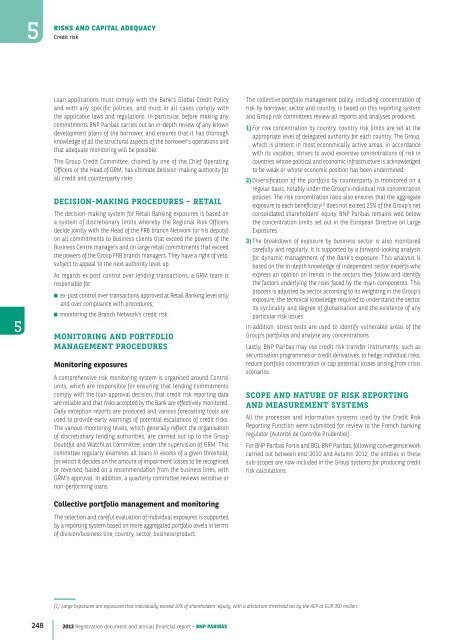2012 Registration document and annual financial report - BNP Paribas
2012 Registration document and annual financial report - BNP Paribas
2012 Registration document and annual financial report - BNP Paribas
- No tags were found...
Create successful ePaper yourself
Turn your PDF publications into a flip-book with our unique Google optimized e-Paper software.
5RISKSAND CAPITAL ADEQUACYCredit risk5Loan applications must comply with the Bank’s Global Credit Policy<strong>and</strong> with any specific policies, <strong>and</strong> must in all cases comply withthe applicable laws <strong>and</strong> regulations. In particular, before making anycommitments <strong>BNP</strong> <strong>Paribas</strong> carries out an in-depth review of any knowndevelopment plans of the borrower, <strong>and</strong> ensures that it has thoroughknowledge of all the structural aspects of the borrower’s operations <strong>and</strong>that adequate monitoring will be possible.The Group Credit Committee, chaired by one of the Chief OperatingOfficers or the Head of GRM, has ultimate decision-making authority forall credit <strong>and</strong> counterparty risks.DECISION-MAKING PROCEDURES – RETAILThe decision-making system for Retail Banking exposures is based ona system of discretionary limits whereby the Regional Risk Officersdecide jointly with the Head of the FRB b ranch Network (or his deputy)on all commitments to Business clients that exceed the powers of theBusiness Centre managers <strong>and</strong> on large retail commitments that exceedthe powers of the Group FRB branch managers. They have a right of veto,subject to appeal to the next authority level up.As regards ex post control over lending transactions, a GRM team isresponsible for:■ ex- post control over transactions approved at Retail Banking level only<strong>and</strong> over compliance with procedures;■ monitoring the Branch Network’s credit risk.MONITORING AND PORTFOLIOMANAGEMENT PROCEDURESMonitoring exposuresA comprehensive risk monitoring system is organised around Controlunits, which are responsible for ensuring that lending commitmentscomply with the loan approval decision, that credit risk <strong>report</strong>ing dataare reliable <strong>and</strong> that risks accepted by the Bank are effectively monitored.Daily exception <strong>report</strong>s are produced <strong>and</strong> various forecasting tools areused to provide early warnings of potential escalations of credit risks.The various monitoring levels, which generally reflect the organisationof discretionary lending authorities, are carried out up to the GroupDoubtful <strong>and</strong> WatchList Committee, under the supervision of GRM. Thiscommittee regularly examines all loans in excess of a given threshold,for which it decides on the amount of impairment losses to be recognisedor reversed, based on a recommendation from the business lines, withGRM’s approval. In addition, a quarterly committee reviews sensitive ornon-performing loans.Collective portfolio management <strong>and</strong> monitoringThe selection <strong>and</strong> careful evaluation of individual exposures is supportedby a <strong>report</strong>ing system based on more aggregated portfolio levels in termsof division/business line, country, sector, business/product.The collective portfolio management policy, including concentration ofrisk by borrower, sector <strong>and</strong> country, is based on this <strong>report</strong>ing system<strong>and</strong> Group risk committees review all <strong>report</strong>s <strong>and</strong> analyses produced.1) For risk concentration by country, country risk limits are set at theappropriate level of delegated authority for each country. The Group,which is present in most economically active areas, in accordancewith its vocation, strives to avoid excessive concentrations of risk incountries whose political <strong>and</strong> economic infrastructure is acknowledgedto be weak or whose economic position has been undermined.2) Diversification of the portfolio by counterparty is monitored on aregular basis, notably under the Group’s individual risk concentrationpolicies. The risk concentration ratio also ensures that the aggregateexposure to each beneficiary (1) does not exceed 25% of the Group’s netconsolidated shareholders’ equity. <strong>BNP</strong> <strong>Paribas</strong> remains well belowthe concentration limits set out in the European Directive on LargeExposures.3) The breakdown of exposure by business sector is also monitoredcarefully <strong>and</strong> regularly. It is supported by a forward-looking analysisfor dynamic management of the Bank’s exposure. This analysis isbased on the in-depth knowledge of independent sector experts whoexpress an opinion on trends in the sectors they follow <strong>and</strong> identifythe factors underlying the risks faced by the main components. Thisprocess is adjusted by sector according to its weighting in the Group’sexposure, the technical knowledge required to underst<strong>and</strong> the sector,its cyclicality <strong>and</strong> degree of globalisation <strong>and</strong> the existence of anyparticular risk issues.In addition, stress tests are used to identify vulnerable areas of theGroup’s portfolios <strong>and</strong> analyse any concentrations.Lastly, <strong>BNP</strong> <strong>Paribas</strong> may use credit risk transfer instruments, such assecuritisation programmes or credit derivatives, to hedge individual risks,reduce portfolio concentration or cap potential losses arising from crisisscenarios.SCOPE AND NATURE OF RISK REPORTINGAND MEASUREMENT SYSTEMSAll the processes <strong>and</strong> information systems used by the Credit RiskReporting Function were submitted for review to the French bankingregulator (Autorité de Contrôle Prudentiel).For <strong>BNP</strong> <strong>Paribas</strong> Fortis <strong>and</strong> BGL <strong>BNP</strong> <strong>Paribas</strong>, following convergence workcarried out between end-2010 <strong>and</strong> Autumn <strong>2012</strong>, the entities in thesesub-scopes are now included in the Group systems for producing creditrisk calculations.(1) Large Exposures are exposures that individually exceed 10% of shareholders’ equity, with a disclosure threshold set by the ACP at EUR 300 million.248<strong>2012</strong> <strong>Registration</strong> <strong>document</strong> <strong>and</strong> <strong>annual</strong> <strong>financial</strong> <strong>report</strong> - <strong>BNP</strong> PARIBAS





